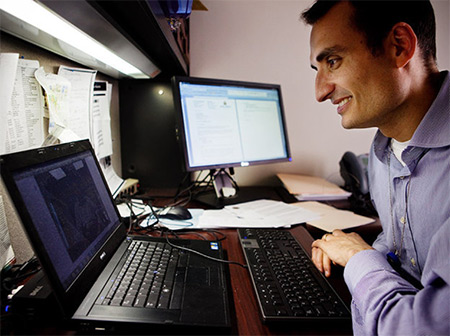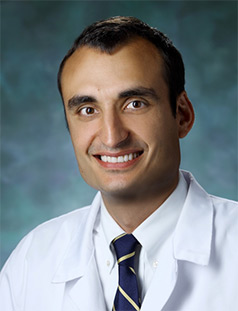What if your next doctor’s appointment involved just booting up your laptop rather than trekking to a clinic or office? Neurologist Ray Dorsey, M.D., M.B.A., is making virtual house calls a reality for people with Parkinson’s disease (PD) and believes “telemedicine” is on the brink of transforming healthcare. “There’s a huge demand for more convenient care,” he says.

What’s telemedicine? Why does it work for PD?
Telemedicine, also called telehealth, is the delivery of healthcare remotely via phone, smartphone, mobile wireless device or other tools with or without a video connection.
Dr. Dorsey, a professor of neurology and the director of the Center for Health and Technology at the University of Rochester Medical Center, has been studying and providing telemedicine for more than a decade – starting with people with PD in a nursing home in a remote part of Central New York. He says virtual visits work particularly well for PD because it’s a visually-assessed condition.
Also, due to geography, physical limitations and other factors, more than 40 percent of people with PD do not see a neurologist – putting them at greater risk for falls, hip fractures and other complications – so there’s ample opportunity to improve care.
Dr. Dorsey’s research findings
In a 2013 pilot study on telemedicine for PD, Dr. Dorsey and his colleagues found that patients who received virtual house calls:
- Spent an average of 53 minutes per call (using technology similar to Skype)
- Saved 4+ hours – plus gas/travel money – for each appointment (compared to the 255-minute average time spent per in-person visit and travel)
- Felt just as well about their quality of life and level of care as patients who attended in-person visits during the seven-month study
Building on the findings of the pilot involving 20 patients, Dr. Dorsey turned to PatientsLikeMe and other organizations to help recruit about 200 patients for a larger study called “Connect.Parkinson” – which resulted in similar positive findings. In fact, patients receiving virtual care rated their care more highly than those receiving in-person care, with 90 percent of patients saying they were “satisfied” or “very satisfied.”
“The biggest perks? Patients found care, convenience and comfort in virtual house calls.”
In patients’ own words:
“Excellent – just wish these visits could continue.”
“The regular intervals of seeing my neurologist through a virtual visit allowed my neurologist to treat more of my symptoms that emerged gradually… I do not have that kind of awareness of how my PD is gradually changing in one-a-year visits with my regular neurologist.”
“As my wife and I live a long way from the nearest neurologist, this technology is a blessing.”
“I really felt comfortable and did not feel like I was missing anything crucial by not being there in person. It’s so nice to not have to get in the car to go to an appointment!!”
 Six-foot-5-inch Dr. Dorsey says meeting with him over a web cam – where he’s seated and not wearing his clinical lab coat – “levels the playing field.”
Six-foot-5-inch Dr. Dorsey says meeting with him over a web cam – where he’s seated and not wearing his clinical lab coat – “levels the playing field.”
“If you come see me in a clinic, you would be clearly be on my turf. When you see me from your home, if you don’t like me, you can just close your computer,” he jokes.
The future of telemedicine
From the get-go of Dr. Dorsey’s latest study, it was clear that there’s a growing demand for telemedicine. Most clinical trials take a while to recruit for, but not “Connect.Parkinson.” The trial page received 11,000 visitors from all 50 states and more than 80 countries, and the study was quickly at capacity.
“We were actually overwhelmed by the interest,” Dr. Dorsey says, “I think there’s just a huge demand in the community to receive care from home.”
Virtual visits aren’t for every patient – or provider, Dr. Dorsey says, noting there’s a learning curve, technical glitches, personalities and some privacy concerns to consider. Also, virtual care shouldn’t be a substitute for in-person visits but work well as a complement to them, for example, in the months between annual checkups.
While telemedicine might become a go-to for things like PD, skin conditions, and mental health issues, it probably isn’t a great fit for conditions requiring regular lab work and face-to-face evaluation, such as lupus or cardiovascular disease. But Dr. Dorsey believes it’s poised for exponential growth as more patients and politicians (who are always budgeting for Medicare) catch onto its perks.
“With time, I think more people are going to say, ‘I shop online, I bank online – why can’t I get healthcare online?’”
-Dr. Dorsey.
Free telehealth for New Yorkers with PD
As part of Dr. Dorsey’s work in expanding telemedicine, anyone with PD in New York State can receive care for free through a program called Parkinson’s Disease Care New York. Get the details at pdcny.org. He hopes the program can be replicated in other states – and for other conditions – in the future.
See what PatientsLikeMe members with PD are saying about telemedicine.
 Share this post on Twitter and help spread the word.
Share this post on Twitter and help spread the word.
